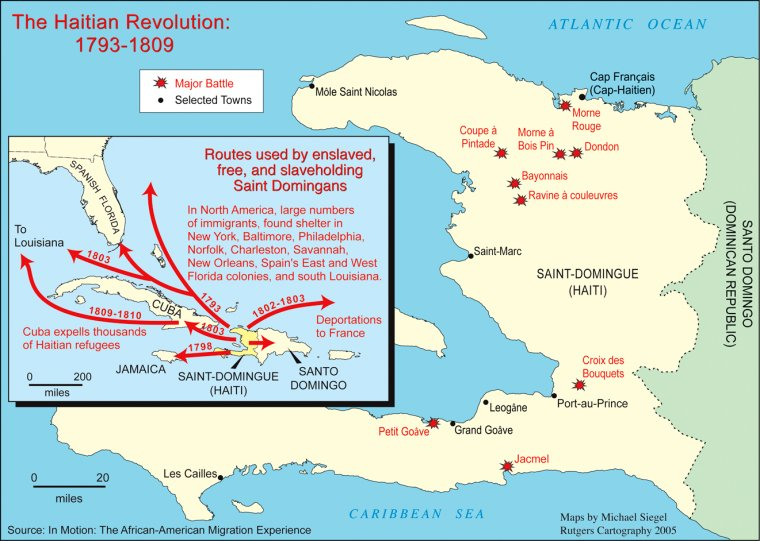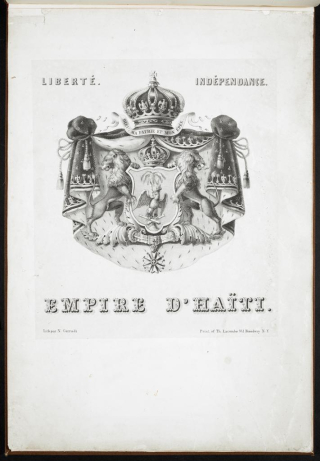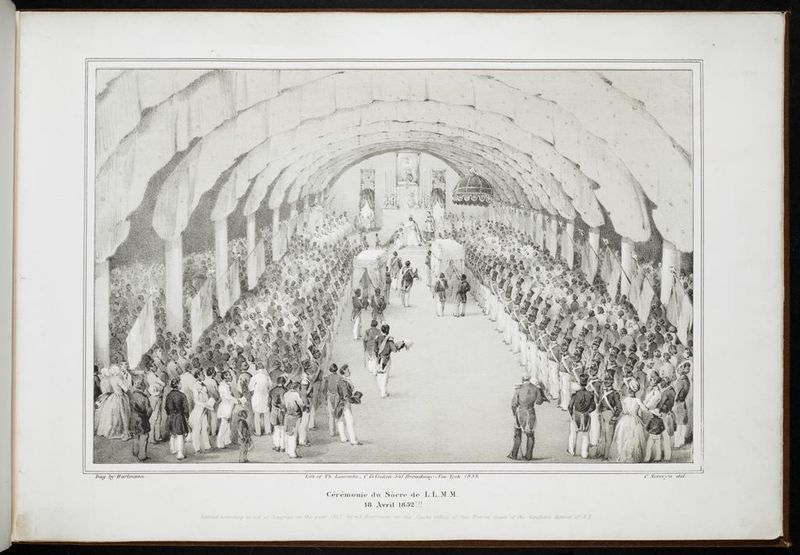
HAITI
El tercio oeste de la isla de Hispaniola, que comparte con RD
Creole- Kwéyol (mezcla entre francés, inglés y español)
hoy en dia creole y frances son reconocidos f como seugnda lengua
HISTORICAL OVERVIEW
mid s.XVII los franceses comenzaron a desplazar a los españoles
1697→ fue cedido a francia por un tratado, lo llamaron St. Domungue
(mapa con flechas de migracion desde: africa, francia españa)
“marrons”: escaped slaves→ quienes huyeron a al interior de la montañosa y boscosa isla
terreno ideal para esconderse y formar comunidades, que se convirtieron en bases de la revolucion
segunda revolucion efectiva en el hemisferio (después de usa)
primer Black freedom movement in the world

inspirados en los ideales de la revolucion francesa→ se revelan en 1798 liderados por el legendario Toussaint L’Overture
declaran la indem¡pendencia en 1804 y se declaran “Haití”, palabra Taíno que significa montañas altas
entre la independencia y 1860 la iglesia católica no tenía presencia oficial en el país or lo que las religiones africanas fueron muy prominenetes por multiples generaciones
1915- 20 year occupation de usa (introducción del jazz y el swing a la música haitiana)
1935- retirada de usa, siguen una serie de dictaduras cortas
1957- power grab de François “Papa Doc” Duvalier, hasta 1971 que muere y su hijo Jean-Claude “Baby Doc” asume el poder
1986- popular rising y termina la dictadura
Négritude and Haitian Art
1930 y 1940, importantes desarrollos artisticos y literarios surgen en las french-speaking islas del caribe
Négritude→ movimiento anti-colonial que busacba definir y avanzar la identidad negra en las colonias y reconectar a sus habitantes con sus raices africanas
literatura:
Aimé Césaire, `poeta dramaturgo y alcalde(?)
Léopold Sédar Senghor, poeta→ futuro presidente de senegal
Négritude influenció muchos otros movimientos en el mundo como la Harlem Renaissance y la pre-eminancia del arte haitiano que en el siglo xx alcanzó un unprecedented leve of world-acclaim
arte haitiano- embraced indigenisme, search for african roots. emphasizes bright colors and depicts forest scenes of everyday life as well as vodou rituals y haitian rev
VODOU
significa “espíritu” o “deidad” en el lenguaje Fon de Benin
equivalentes de los orishas de la santería cubana y los orixas de Blrasil
como otros paises con alta cantidad de personas africanas en condición de esclavitud, desarrollaron su propia mezcla de ritos africanos y europeos
Vodou (voudou, vaudou, voodoo o vodun), sistema sincretico de creencias que surge en el s. xvii en las plantaciones de caña y marron communities
varios lideres de revolucion eran sacerdote vodou, como:
Guinean François Mackandal, revolución de 6 años que termina con su ejecucion en 1758
Boukman, similar uprising en 1791
nace ne slave plantations y simboliza el struggle for independence del l8 s. xviii
importante expresion de la determinacion haitiana que ayuda al movimiento revolucionario de L’Overture
plantation owners y catolicos asociaron el vodou con satanismo y el “mal”
potomitan→ un poste de madera que conecta la tierra, agua y cielo por el que viajan los espíritus. se pone en el centro de los rituales
los rituales aim ffor un estado de trance que abre la puerta a los espítirus y permite la comunicacion y/o posesion de un Iwa en específico
assistance de ancestros
si es exitoso el ritual, el Iwa participa del ritual e incluso pide que muscia quiere que sea tocada
tanbou drums are considered deities, respected while in use, put to “sleep” at other times
several distinct drumming styles are linked to particular areas of the country:
petwo derivado de africa central (congo, angol, mozambique), asociado con los violent clashes de la independencia. usa 3 tambores conicos de cuero de cabra manman, ralé kata, usualmente mas pequeños que los rada drums, se tocan con la mano
rada derivado de africa oeste (ghana, nigeria, togo, benin). este ritmo usa 3 tambores de cuero de vaca manman, segon y boula (mother, second, small), tocados con baquetas
otros estilos: bizango, dahomey, mayi, gedé y banda
kasé: improvisatory section played over the main rhythm
RARÁ
carnaval en medio de la cuaresma: mi-carēme (id-lent)
raise to festival rará de fertilidad
celebración rural, referida como “peasant” carnival
is a secular celebration
strict rules control the playing, singing and dancing
importamt rará centers: Léigane in the south
Artibonite valleyin the north
DANZAS SECULARES
franceses: gavottes, minuets, valses→ “africanizados”
menwat→ derivado del minuet
méringue→ s.xviii en formal balls y runiones informales
si es exitoso el ritual, el Iwa participa del ritual e incluso pide que muscia quiere que sea tocada
tanbou drums are considered deities, respected while in use, put to “sleep” at other times
several distinct drumming styles are linked to particular areas of the country:
petwo derivado de africa central (congo, angol, mozambique), asociado con los violent clashes de la independencia. usa 3 tambores conicos de cuero de cabra manman, ralé kata, usualmente mas pequeños que los rada drums, se tocan con la mano
rada derivado de africa oeste (ghana, nigeria, togo, benin). este ritmo usa 3 tambores de cuero de vaca manman, segon y boula (mother, second, small), tocados con baquetas
otros estilos: bizango, dahomey, mayi, gedé y banda
kasé: improvisatory section played over the main rhythm
RARÁ
carnaval en medio de la cuaresma: mi-carēme (id-lent)
raise to festival rará de fertilidad
celebración rural, referida como “peasant” carnival
is a secular celebration
strict rules control the playing, singing and dancing
importamt rará centers: Léigane in the south
Artibonite valleyin the north
SECULAR DANCES
franceses: gavottes, minuets, valses→ “africanizados”
menwat→ derivado del minuet
méringue→ s.xviii en formal balls y runiones informales
COMPAS AND CADENCE
from the heavily latinized context, 1950s→ new haitian style: compas direct, abrev. compas/konpa
danza, combina el méringue con influencias extranjeras incluidas:
merengue dominicano
son cubano
calypso y soca de trinidad
reggae de jamaixa
soukous- afropop congolest
19th century:
establishment of the military wind band, or fanfare, as the only provider of a steady income for professional musicians.
Fanfares were located in the principal towns and provided Sunday concerts featuring a repertory of fashionable quadrilles, marches and waltzes of European origin.

1860→ concordat with the Vatican→ influx of trained music teachers of the religious orders:
establish schools, which soon founded their own fanfares, rivalling the more polished, government-sponsored groups.
Indigenous art music has its origins in the French colonial period, when symphonies and concertos were composed by theatre musicians.
After the revolution there was a desire to retain European standards while including local features.
The compositions of Occide Jeanty (1860–1936), bandleader of the government’s Musique du Palais, typify this tendency: his medium was the fanfare, for which he produced works with a political dimension, such as his 1804 commemorating the independence of Haiti.
The shock of the American occupation of 1915–34 resulted in a greater emphasis being placed on folk elements by such composers:
Ludovic Lamothe (1882–1953)
Justin Elie (1883–1931)
Franck Lassègue (1890–1940)
(i) Song
Songs are almost always sung in call-and-response fashion between the song leader and the congregation, spoken of in Haiti as voye chante (‘sending a song’) and ranmase chante (‘gathering a song’).
he majority of Vodou songs are of an anhemitonic pentatonic character, occasionally with added transitional tones. Some alternate between two tonal centres, often a tone apart.
(ii) Rituals
(a) Rada rites
The majority of Rada rhythms are in what might be described as a 12/8 metre. The boula pattern on the second and third beats of each group of three is also relatively invariant across this repertory
Common rhythms played in Rada ceremonies include yanvalou (the centrepiece of a Rada dans), mayi, zepòl and nago. Dances typically proceed anticlockwise around the poto mitan, but changes in the choreography are introduced by ‘breaks’ (kase) in the rhythm, which often have the effect of precipitating possessions. Fleurant (1996) has classified the obligatory sequences of dances that appear in Rada ceremonial contexts.
(b) Petwo-Kongo
The lwa of Petwo are typically hotter in temperament, more demonstrative and theatrical
(3) Gède and banda
The Gède spirits (such as Bawon Samdi and Gède Nibo) rule the cemetery, govern transitions between life and death, and have an important role in fertility and rebirth. Despite their Dahomey origins, they stand somewhat outside Rada and Petwo, tending to be comically obscene, unpredictable or even terrifying.
A number of repressive campaigns have been carried out against Vodou in the belief that it is primitive or demonic, including the anti-superstition or renunciation campaign of the early 1940s. In the late 1980s, many Vodou priests were killed in the aftermath of the overthrow of the Duvalier dictatorship because of the high rate of ougan (officiants) in Duvalier’s militia (the Tonton Makout)
2. Music of festivals, daily life and recreation
(i) Rara
This springtime festivity takes place largely during Lent and increases in frequency towards Easter weekend. It appears to have developed from the French colonial practice of holding a second carnival (Carnaval Carême) at the end of Lent, prior to Easter, when slave processionals with mock-royal costumes visited the ‘great houses’ on the plantation to solicit donations of food and money.
There are many tuning systems used for vaksin but usually they exploit approximate minor 3rd intervals (creating tritones and arpeggiated diminished chords, but without a harmonic intent), with two of the vaksin often tuned approximately a semitone apart. One of the vaksin pitches generally serves as the tonal centre of rara songs. Like Vodou songs, most rara songs exhibit anhemitonic pentatonic melodies and may contain additional pitches that could be characterized as ‘passing’ tones, with the result that the vaksin and song melodies share some pitches, but also contain other pitches that are exclusive to each and add tension to the overall sound.
(ii) Karnaval
karnaval: creole, 3 days before lent
(iii) Konbit music
konbit: cooperative work association, involves a system of mutual self-help and has counterparts in West African agricultural practices.
The labour is often accompanied by a musical ensemble whose only duty is to entertain and inspire the workers and may include a simpe hoe blade on which the singer taps a timeline, a kongo percussion ensemble or a full complement of vaksin as in a rara ensemble. The simidor (or sanba) leads songs and improvises lyrics on topical subjects. Most observers of rural agriculture note that the institution of konbit is in decline.
(iv) Dance
Among the many kinds of dances performed at parties is the djouba (juba), which is sometimes called matinik, perhaps through its association with immigrants from Martinique
Figure dances were brought to Haiti from France in the 18th century and were taught in rural as well as urban contexts by travelling mèt dans (dance masters); they are still practised in some remote locations.
Genres such as kontradans (contredanse), kadri (quadrille), menwat (minuet), and eliyanse (Lanciers) are still played under thatched shelters in some areas for recreation or to follow Vodou ceremonies (see Yih, 1995 for further discussion of this context).
(v) Children’s songs
strong European influence; they may follow an implicit harmonic progression and undoubtedly descend from European children’s songs
(vi) Obscure instruments
The relative isolation of Haiti’s rural areas has permitted obscure or peripheral instruments (many of African origin) to survive, in some cases played only by children
tanbou marengwen (mosquito drum), which consists of a cord stretched from a small, bent tree to a hole in the ground covered with thatch.
Another instrument of probable African origin is the ganbo (stamping tube), played in an ensemble in which each player stamps two bamboo tubes of different lengths (and pitches) on the ground to create an ostinato that may substitute for a drum battery.
3. Popular music
(i) Méringue
Throughout the Caribbean, European figure dances played by musicians of African descent evolved into new, hybrid styles, often as accompaniment for couple dances. One of the first of these (appearing soon after the founding of Haiti) was the karabinyè (carabinier, the army’s artillery division), the direct precursor of the méringue (see Merengue).
most of the 19th and 20th centuries, the méringue was a national genre, danced at rural informal parties, at working-class bars and at high-class soirées (especially after anti-American sentiment during the US occupation fuelled a nationalist movement among the élite).
Some of the most enduring Haitian méringues (e.g. Choucoune, Souvenir d’Haïti and Angelique O!) were composed by middle-class poets, composers and troubadours; others circulated anonymously as comments on social or political affairs (e.g. Panama M Tombe and Merci Papa Vincent, both ridiculing former presidents of Haiti).
The instrumentation for méringues varies as widely as the contexts. They are played using only percussion instruments after a Vodou ceremony has ended, as parlour méringues (méringues lentes) for élite audiences by chamber groups of piano and strings, in dance halls and hotels by orchestras and in the streets, at festivals and hotels by small troubadou (troubadour) or mizik gwenn siwèl (‘nougat’) ensembles